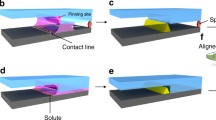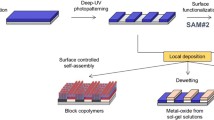Abstract
Self-assembly of structures that are more than a few millimeters in size is a current problem that can have broad applications in new ways to construct the objects that we use. As a step in that direction, fluidic self-alignment at the wafer-to-wafer level is demonstrated, characterized, and modeled. Although self-alignment of millimeter-sized objects has previously been shown, several physical processes become important as the structure size is increased to a whole wafer. These processes are measured and modeled in this paper. Self-assembled monolayers, both natural and modified by oxidation, are used to create surface energy gradients that are used to produce capillary alignment forces. These forces exceed the wafer-edge forces. The measured capillary fluid profile is modeled to predict the alignment forces with no adjustable parameters. Alignment forces are measured and the trends are predicted as the surface tension of the liquid, hence the generated force, is varied. These considerations govern pattern design rules, which are described and ensure a long capture range, high alignment force, and avoidance of wafer-edge dragging.
Graphic abstract











Similar content being viewed by others
References
Arutinov G, Smits ECP, Mastrangeli M, Heck G, Brand J, Schoo HFM, Dietzel A (2012) Capillary self-alignment of mesoscopic foil components for sensor-systems-in-foil. J Micromech Microeng 22:115022
Arutinov G, Mastrangeli M, Smits ECP, van Heck G, den Toonder JMJ, Dietzel A (2015) Foil-to-foil system integration through capillary self-alignment directed by laser patterning. J Microelectromech Syst 24:126–133
Berthier J, Mermoz S, Brakke K, Sanchez L, Fretigny C, Cioccio LD (2013) Capillary self-alignment of polygonal chips: A generalization for the shift-restoring force. Microfluid Nanofluid 14:845–858
Berthier J, Brakke K, Grossi F, Sanchez L, Di Cioccio L (2010) Self-alignment of silicon chips on wafers: a capillary approach. J Appl Phys 108
Böhringer KF (2003) Surface modification and modulation in microstructures: controlling protein adsorption, monolayer desorption and micro-self-assembly. J Micromech Microeng 13:S1–S10
Böhringer K, Srinivasan U, Howe R (2001) Modeling of capillary forces and binding sites for fluidic self-assembly. Technical Digest. MEMS 2001. 14th IEEE International Conference on Micro Electro Mechanical Systems (Cat. No.01CH37090). pp 369–374, ISSN: 1084-6999
Brakke KA (1992) The surface evolver. Exp Math 1:141–165. https://doi.org/10.1080/10586458.1992.10504253
Chang B, Zhou Q, Wu Z, Liu Z, Ras RHA, Hjort K (2016) Capillary self-alignment of microchips on soft substrates. Micromachines 7:41
Chang B, Zhu Z, Koverola M, Zhou Q (2017) Laser-assisted mist capillary self-alignment. Micromachines 8:361
Chau A, Régnier S, Delchambre A, Lambert P (2010) Theoretical and experimental study of the influence of AFM tip geometry and orientation on capillary force. J Adhes Sci Technol 24:2499–2510
de Gennes P-G, Brochard-Wyart F, Quéré D (2004) Capillarity and wetting phenomena. Springer, New York
De Vos J, Peng L, Phommahaxay A, Van Ongeval J, Miller A, Beyne E, Kurz F, Wagenleiter T, Wimplinger M, Uhrmann T (2016) Importance, of alignment control during permanent bonding and its impact on via-last alignment for high density 3D interconnects. In: IEEE International 3D Systems Integration Conference (3DIC). Piscataway, NJ, USA 2016:5
Dragoi V, Burggraf J, Kurz F, Rebhan B (2015) 3D integration by wafer-level aligned wafer bonding. In: Proceedings of the international semiconductor conference, CAS. Sinaia, Romania, pp 185–188
Emanuel A (2011) A novel covalent nanoglue and whole wafer self-alignment based upon self-assembled monolayers. Ph.D. Dissertation, North Carolina State University, Raleigh
Emanuel A, Hallen HD (2018) A self-assembled covalent nanoglue. Transl Mater Res 5:025001
Flotgen C, Razek N, Dragoi V, Wimplinger M (2016) Conductive semiconductor interfaces fabricated by room temperature covalent wafer bonding. ECS Transactions, Honolulu, pp 45–51
Fukushima T, Hashiguchi H, Kino H, Tanaka T, Murugesan M, Bea J, Hashimoto H, Lee K, Koyanagi M (2016) Transfer and non-transfer 3d stacking technologies based on multichip-to-wafer self-assembly and direct bonding. In: Proceedings—electronic components and technology conference. Las Vegas, NV, United States, pp 289–294
Fukushima T, Iwata E, Konno T, Bea J-C, Lee K-W, Tanaka T, Koyanagi M (2010) Surface tension-driven chip self-assembly with load-free hydrogen fluoride-assisted direct bonding at room temperature for three-dimensional integrated circuits. Appl Phys Lett 96
Fukushima T, Iwata E, Lee K.-W, Tanaka T, Koyanagi M (2010) Self-assembly technology for reconfigured wafer-to-wafer 3D integration. In: Proceedings—electronic components and technology conference. Las Vegas, NV, United states. pp 1050–1055
Fukushima T, Iwata E, Ohara Y, Murugesan M, Bea J, Lee K, Tanaka T, Koyanagi M (2011) Multichip self-assembly technology for advanced die-to-wafer 3-D integration to precisely align known good dies in batch processing. In: IEEE transactions on components, packaging and manufacturing technology. 445 Hoes Lane / P.O. Box 1331, Piscataway, NJ 08855-1331, United States; pp 1873–1884
Gaudin G, Riou G, Landru D, Tempesta C, Radu I, Sadaka M, Winstel K, Kinser E, Hannon R (2010) Low temperature direct wafer to wafer bonding for 3D integration: Direct bonding, surface preparation, wafer-to-wafer alignment. In: IEEE 3D system integration conference, (2010) 3DIC 2010. Munich, Germany, p 2010
Gueguen P, Ventosa C, Cioccio LD, Moriceau H, Grossi F, Rivoire M, Leduc P, Clavelier L (2010) Physics of direct bonding: Applications to 3D heterogeneous or monolithic integration. Microelectron Eng 87:477–484
Hallen MA, Hallen HD (2008) Synthesis of carboxylic acid monolayers by ozonolysis of 10-undecenyltrichlorosilane SAMs. J Phys Chem C 112:2086–2090
Halliday D, Resnick R, Walker J (2013) Fundamentals of physics, 10th edn. Wiley, Oxford
Koyanagi M, Lee K, Fukushima T, Tanaka T (2016) New multichip-to-wafer 3D integration technology using Self-Assembly and Cu nano-pillar hybrid bonding. In: 2016 13th IEEE international conference on solid-state and integrated circuit technology, ICSICT 2016—proceedings. Hangzhou, China, pp 338–341
Kurz F, Plach T, Suss J, Wagenleitner T, Zinner D, Rebhan B, Dragoi V (2016) High precision low temperature direct wafer bonding technology for wafer-level 3D ICs manufacturing. ECS Trans (USA) 75:345–53
Lambert P, Delchambre A (2005) Parameters ruling capillary forces at the submillimetric scale. Langmuir 21:9537–9543
Lambert P, Chau A, Delchambre A, Régnier S (2008) Comparison between two capillary forces models. Langmuir 24:3157–3163
Lambert P, Mastrangeli M, Valsamis J-B, Degrez G (2010) Spectral analysis and experimental study of lateral capillary dynamics for flip-chip applications. Microfluid Nanofluid 9:797–807
Lee SH, Chen K-N, Lu JJ-Q (2011) Wafer-to-wafer alignment for three-dimensional integration: A review. J Microelectromech Syst 20:885–898
Lu J, Nakano Y, Takagi H, Maeda R (2013) High-efficient chip to wafer self-alignment and bonding applicable to MEMS-IC flexible integration. IEEE Sens J 13:651–656
Lu J, Takagi H, Nakano Y, Maeda R (2013) Size-free MEMS-IC high-efficient integration by using carrier wafer with self-assembled monolayer (SAM) fine pattern. In: Proceedings—electronic components and technology conference. Las Vegas, NV, United states, pp 1508–1513
Martin BR, Furnange DC, Jackson TN, Mallouk TE, Mayer TS (2001) Self-alignment of patterned wafers using capillary forces at a water-air interface. Adv Funct Mater 11:381–386
Mastrangeli M (2015) The fluid joint: the soft spot of micro- and nanosystems. Adv Mater 27:4254–4272
Mastrangeli M, Abbasi S, Varel C, Hoof CV, Celis J-P, Böhringer KF (2009) Self-assembly from milli- to nanoscales: methods and applications. J Micromech Microeng 19:083001
Mastrangeli M, Ruythooren W, Hoof CV, Celis J-P (2009) Conformal, dip-coating of patterned surfaces for capillary die-to-substrate self-assembly. J Micromech Microeng 19:045015
Mastrangeli M, Ruythooren W, Celis J-P, Van Hoof C (2011) Challenges for capillary self-assembly of microsystems. IEEE Trans Compon Packag Manuf Technol 1:133–149
Mastrangeli M, Arutinov G, Smits ECP, Lambert P (2015) Modeling capillary forces for large displacements. Microfluid Nanofluid 18:695–708
Mastrangeli M, Zhou Q, Sariola V, Lambert P (2017) Surface tension-driven self-alignment. Soft Matter 13:304–327
Narimannezhad A, Jennings J, Weber M, Lynn K (2016) Pushing the limits of bonded multi-wafer stack heights while maintaining high precision alignment. J Microelectromech Syst (USA) 25:725–36
Ohba T, Maeda N, Kitada H, Fujimoto K, Suzuki K, Nakamura T, Kawai A, Arai K (2010) Thinned wafer multi-stack 3DI technology. Microelectron Eng 87:485–490
Sanchez L, Bally L, Montmayeul B, Fournel F, Dafonseca J, Augendre E, Di Cioccio L, Carron V, Signamarcheix T, Taibi R, Mermoz S, Lecarpentier G (2012) Chip to wafer direct bonding technologies for high density 3D integration. In: Proceedings–electronic components and technology conference. San Diego, CA, United states, pp 1960–1964
Sugaya I, Mitsuishi H, Maeda H, Tsuto T, Nakahira H, Okada M, Okamoto K (2015) Precision wafer bonding process for future cost-effective 3DICs. In: 26th Annual SEMI advanced semiconductor manufacturing conference, ASMC. Saratoga Springs, NY, United states, 2015, pp 429–434
Terfort A, Bowden N, Whitesides GM (1997) Three-dimensional self-assembly of millimetre-scale components. Nature 386:162–164
Tsai CG, Hsieh CM, Yeh JA (2007) Self-alignment of microchips using surface tension and solid edge. Sens Actuators A Phys 1–2:343–349
Uddin A, Milaninia K, Chen C.-H, Theogarajan L (2011) Wafer scale integration of CMOS chips for biomedical applications via self-aligned masking. In: IEEE transactions on components, packaging and manufacturing technology. 445 Hoes Lane / P.O. Box 1331, Piscataway, NJ 08855-1331, United States. pp 1996–2004
Walker III EM, Emanuel A, Hallen HD. Self alignment of whole wafers using patterning for capillary forces (submitted)
Xiao J, Chaudhuri RR, Seo S-W (2016) Heterogeneous Integration of Thin-Film Optical Devices Utilizing Fluidic Self-Assembly and Micro-Pick-and-Place Technique. IEEE Trans Compon Packag Manuf Technol 6:1283–1289
Acknowledgements
This work was supported by AFRL-WPAFB (Grant FA8650-04-2-1619).
Author information
Authors and Affiliations
Corresponding author
Additional information
Publisher's Note
Springer Nature remains neutral with regard to jurisdictional claims in published maps and institutional affiliations.
Rights and permissions
About this article
Cite this article
Emanuel, A., Walker, E.M. & Hallen, H.D. Modified SAMs and templates for achieving self-alignment of full wafers. Microfluid Nanofluid 24, 49 (2020). https://doi.org/10.1007/s10404-020-02352-4
Received:
Accepted:
Published:
DOI: https://doi.org/10.1007/s10404-020-02352-4




